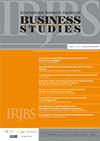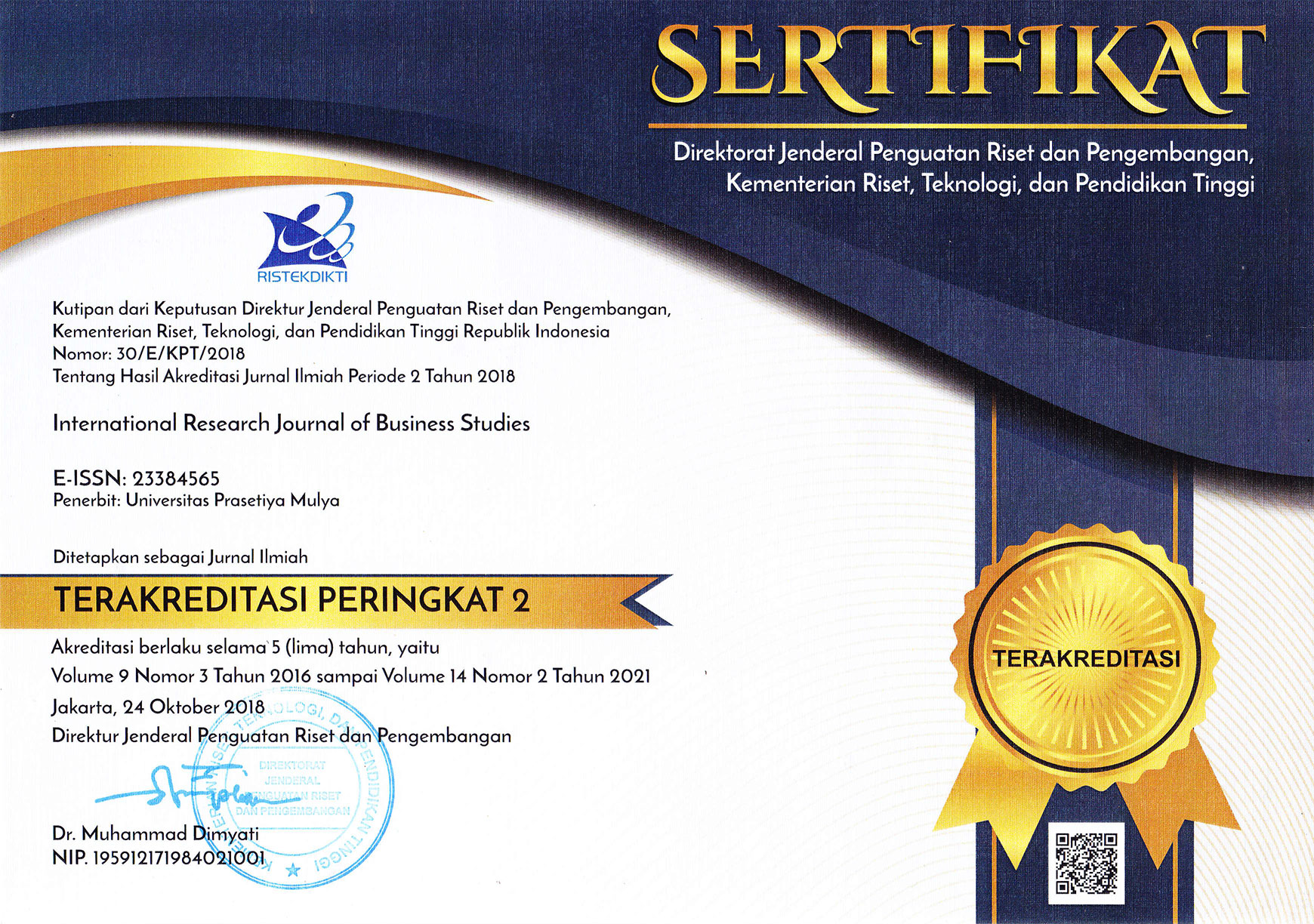Career Persistence Model for Female Engineers in the Indonesian Context
DOI:
https://doi.org/10.21632/irjbs.10.1.23-38Keywords:
female engineer, career persistence, socio-cultural influence, social harmonAbstract
Extant studies about female engineers have suggested their career persistency in the engineering career is influenced by the workplace, which is characterized by male dominated culture making them feel marginalized. In Indonesia, similar studies for reference are limited. This paper is based on an exploratory quantitative study using a questionnaire developed based on the Career Persistence Model. This paper is based on an empirical exploratory quantitative study by adopting Buse’s et al. Career Persistence Model (2013). The intention is to contribute to the literature in the context of Indonesia. It explores the Indonesian cultural dimensions and investigates their relationship to the roles of women in family, society and the workplace, and how women manage to navigate barriers to avoid taking alternative career paths. Contrary to extant studies, findings show women feel equally treated to men in the workplace, however some work demands may hinder. The strong acknowledgement of one’s roles in this collective society outdoes the opinions that the Islamic jurisprudence (fiqh) has marginalized empowerment of women, resulting in gender-based injustices and discrimination. Future studies should look into social supports at the workplace in an attempt to retain and increase the share of women in the engineering career in Indonesia).
References
Badan Kejuruan Kimia Persatuan Insinyur Indonesia. (2013, April 13). Masih sedikit yang melirik dunia teknik. Retireved from
Badan Kejuruan Kimia Persatuan Insinyur Indonesia website: http://www.insinyurkimia.com/artikel/82-masih-sedikityang-melirik-dunia-teknik
Bandura, A. (1997). Self-efficacy: The exercise of control. New York: Freeman.
Bandura, A. (1977). Self-efficacy: Toward a unifying theory of behavioral change. Psychological Review, 84, 191-215.
Bandura, A. (1986). Social foundations of thought and action: A social cognitive theory. Englewood Cliffs, NJ: Prentice-Hall.
Bandura, A. (1999). Social cognitive theory of personality. In L. A. Pervin & O. P. John (Eds.), Handbook of personality: Theory and research (pp. 154-196). New York: Guilford.
Bandura, A. (2001). Social cognitive theory: An agentic perspective. Annual Review of Psychology, 52, 1-26.
Brown, R.B. (2006), Doing your Dissertation in Business and Management. SAGE
Buse, Bilimoria, Perelli, (2013),»Why they stay: women persisting in US engineering careers», Career Development International, Vol. 18 Iss 2 pp. 139 - 154
Castle, D. (2014, June 25). Towards Gender Parity In Asian Science & Tech. Retrieved from Asian Scientist Magazine at: https://www.asianscientist.com/2014/06/features/gender-parity-asian-science-tech-2014/
Couper, M.P. (2000). Web Surveys: A Review of Issues and Approaches - Semantic Scholar. Public Opinion Quarterly Volume 64:464–494. by the American Association for Public Opinion Research
Cochrane, j. (2016, Dec 18). Indonesia’s Dire Need for Engineers Is Going Unmet. (2016, Dec 13). The New York Times.
Darmadji, Ahmad. (2014). Kaidah_Wanita_Karir_Perspektif_Pendidikan_Islam_dalam_Keluarga. UAB Media
Fouad, Singh, Fitzpatrick, & Liu. (2012). “Stemming the tide: why women leave engineering”, Women in Engineering, available at: www.studyofwork.com/wp-content/uploads/2011/03/NSF_Women-Executive-Summary-0314.pdf
Fouad, Nadya A. (2002). Cross-cultural differences in vocational interests: Between groups differences on the Strong Interest Inventory. Journal of Counseling Psychology, 49, 283-289.
Gareta, S.P. (2015, Feb 4). 50 persen insinyur bekerja tak sesuai bidangnya. Antara News. Retrived from Antara News Website : http://www.antaranews.com/berita/478131/50-persen-insinyur-bekerja-tak-sesuai-bidangnya
Geertz, C. (1976). Art as a Cultural System - Cultural Heritage. MLN, Vol.91, No. 6, Comparative Literature
Geertz, C. (1961). Women and Households in Indonesia: Cultural Notions and Social Practices.
Mead, Herbert G. (1925). The Genesis of Self and Social Control. International Journal of Ethics, Vol 35, Issue 3, 251-277
Hasyim, Phil Syafiq (2015, March 9). Gender, the Problem of Patriarchy and Maslaha in Indonesian Islam: From Fiqh al-Abawi to Fiqh al-Nisâ. Jurnal Perempuan. Retrieved from Jurnal Perempuan Website : http://www.jurnalperempuan.org/blog/gender-the-problem-of-patriarchy-and-maslaha-in-indonesian-islam-from-fiqh-al-abawi-to-fiqh-al-nisa
Hersh, M. 2000. The changing position of women in engineering worldwide. IEEE Transactions of Engineering Management, 47(3): 345-359
Hewlett, Luce, Servon, Sherbin, Shiller, Sosnovich, & Sumberg. (2008). The Athena factor: Reversing the brain drain in science, engineering, and technology. Cambridge: Harvard Business School Publishing Corporation
Jorgenson. (2002). Engineering selves: Negotiating gender and identity in technical work. Management Communication Quarterly, 15(3): 350-380.
Hofstede, G. (1984). Cultural dimensions in management and planning. Asia Pacific Journal of Management, Volume 1, Issue 2, pp 81–99
Hofstede, G.,& Hofstede, G.J. (2005). Cultures and organizations: Software of the mind, revised and expanded (2nd ed.). New York: McGraw-Hill
Indonesian Cabinet Secretary Office. (2015, May 15). Sudah punya 700 ribu, Indonesia masih butuh 120 ribu insinyur. Retrived
from the Indonesian Cabinet Secretary Office website : http://setkab.go.id/sudah-punya-700-ribu-indonesia-masih-butuh-120-ribu-insinyur/
Indonesia Kekurangan 120.000 Insinyur 5 Tahun ke depan. (2015,may 12). Detik Online. Retrived from Detik website : http://finance.detik.com/ekonomi-bisnis/2913482/indonesia-kekurangan-120000-insinyur-5-tahun-ke-depan
Indonesia Population 2017. Retrieved from World Population Review website: http://worldpopulationreview.com/countries/
indonesia-population/
Kelley, K. et all (2003). Good practice in the conduct and reporting of survey research.
Kelley K, Clark B, Brown V, Sitzia J. (2003). Good practice in the conduct and reporting of survey research. . Int J Qual Health Care. 2003 Jun;15(3):261-6.
Koentjaraningrat. (1985). Javanese Culture. Southeast Asian Studies Program (Institute of Southeast Asian Studies). Oxford University Press
Lent, R. W., Brown, S. D., & Hackett, G. (1994). Toward a unifying social cognitive theory of career and academic interest, choice, and performance [Monograph]. Journal of Vocational Behavior, 45, 79 122.
Lent, (2005). A social cognitive view of career development and counseling. In S. D. Brown& R. T. Lent (Eds.), Career development and counseling: Putting theory and research to work (pp. 101–127). Hoboken, NJ: Wiley.
Lent, Brown, & Hackett. (2002). Social cognitive career theory. In D. Brown &Associate (Eds.), Career choice and development (4th ed., pp. 255–311). San Francisco, CA:Jossey-Bass.
Meiksins, et al. (2016, Oct 28). The State of Womenin Engineering. Retrieved from SWE Magazine website: http://alltogether.swe.org/wp-content/uploads/2016/11/State-of-Women-in-Engineering.pdf
Mulder. (1978). The Javanese Family. Retrieved from the United Nation University website: http://archive.unu.edu/unupress/
unupbooks/uu13se/uu13se09.htm
Nazmudin, A. (2016, Dec 20). Indonesia Dinilai Masih Kekurangan Insinyur. Warta Kota
Park and Jung. (2009). A Note on Determination of Sample Size for a Likert Scale. Communications of the Korean Statistical Society, Vol. 16, No. 4, 669–673
Rhodes and Doering. (1983). An Integrated Model of Career Change. The Academy of Management Review Vol. 8, No. 4, pp. 631-639
Sandhusen, R.L. (2000). Marketing. Barron’s
Sekaran, S. Uma. (2006). Research Methods for Business. John Wiley and Sons Ltd
Silbey. Susan S (2016). Why Do So Many Women Who Study Engineering Leave the Field?. Retrieved from HBR websites:
https://hbr.org/2016/08/why-do-so-many-women-who-study-engineering-leave-the-field
Singh, Fouad, Fitzpatrick, Liu, & Cappaert. 2013. Stemming the tide: Predicting women engineers’ intentions to leave. Journal of Vocational Behavior 83 (2013) 281–294.
Skarupova, Katerina (2014). TECHNICAL REPORT: Computer-assisted and online data collection in general population surveys. Eropean Monitoring Center for Drugs and Drugs Addiction
Sujatmiko, E. (2004, January). Indonesia Lacks Engineers to Face AEC, says PII. Tempe Magazine. Retived from Tempo magazine website : https://en.tempo.co/read/news/2016/01/02/055732529/Indonesia-Lacks-Engineers-to-Face-AEC%20-%20says-PII
Taylor, C. 2014. Why Tech’s Hottest Companies Want To Hire More Female Engineers. Retrieved from: https://techcrunch.com/2013/10/06/why-tech-companies-hiring-female-engineers/
THE JAKARTA POST. (2016, August 26). Indonesia ranks second-last in reading interest: Study. Retrieved from: http://www.
thejakartapost.com/life/2016/08/29/indonesia-ranks-second-last-in-reading-interest-study.html
UNDP. (2015, Human Development Report 2015 Work for Human Development. Retrieved from the UNDP website : http://
hdr.undp.org/sites/default/files/2015_human_development_report.pdf
Offenhauer, Priscilla (2005). WOMEN IN ISLAMIC SOCIETIES: A SELECTED REVIEW OF SOCIAL SCIENTIFIC LITERATURE. The Library of Congress. Retrieved from The Library of Congress website : https://www.loc.gov/rr/frd/pdf-files/Women_Islamic_Societies.pdf
Downloads
Submitted
Published
How to Cite
Issue
Section
License
Copyright (c) 2018 Lies Dahlia, Lenny Sunaryo

This work is licensed under a Creative Commons Attribution-ShareAlike 4.0 International License.
Journal Author(s) Rights
For IRJBS to publish and disseminate research articles, we need publishing rights (transferred from the author(s) to the publisher). This is determined by a publishing agreement between the Author(s) and IRJBS. This agreement deals with the transfer or license of the copyright of publishing to IRJBS, while Authors still retain significant rights to use and share their own published articles. IRJBS supports the need for authors to share, disseminate and maximize the impact of their research and these rights, in any databases.
As a journal Author, you have rights to many uses of your article, including use by your employing institute or company. These Author rights can be exercised without the need to obtain specific permission. Authors publishing in IRJBS journals have comprehensive rights to use their works for teaching and scholarly purposes without needing to seek permission, including:
- use for classroom teaching by Author or Author's institution and presentation at a meeting or conference and distributing copies to attendees;
- use for internal training by the author's company;
- distribution to colleagues for their research use;
- use in a subsequent compilation of the author's works;
- inclusion in a thesis or dissertation;
- reuse of portions or extracts from the article in other works (with full acknowledgment of the final article);
- preparation of derivative works (other than commercial purposes) (with full acknowledgment of the final article);
- voluntary posting on open websites operated by the author or the author’s institution for scholarly purposes,
(But it should follow the open access license of Creative Common CC-by-SA License).
Authors/Readers/Third Parties can copy and redistribute the material in any medium or format, as well as remix, transform, and build upon the material for any purpose, even commercially. Still, they must give appropriate credit (the name of the creator and attribution parties (authors' detail information), a copyright notice, an open access license notice, a disclaimer notice, and a link to the material), provide a link to the license, and indicate if changes were made (Publisher indicates the modification of the material (if any) and retain an indication of previous modifications.
Authors/Readers/Third Parties can read, print and download, redistribute or republish the article (e.g. display in a repository), translate the article, download for text and data mining purposes, reuse portions or extracts from the article in other works, sell or re-use for commercial purposes, remix, transform, or build upon the material, they must distribute their contributions under the same license as the original Creative Commons Attribution-ShareAlike (CC BY-SA).
This work is licensed under a Creative Commons Attribution-ShareAlike 4.0 International License.








